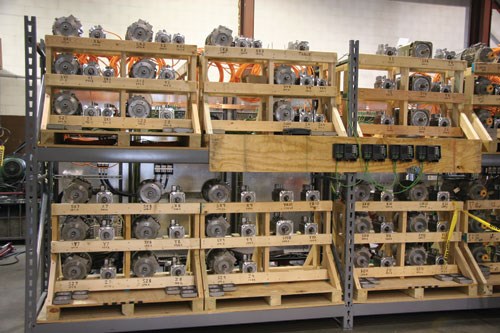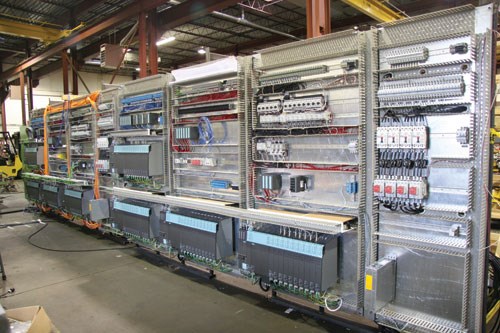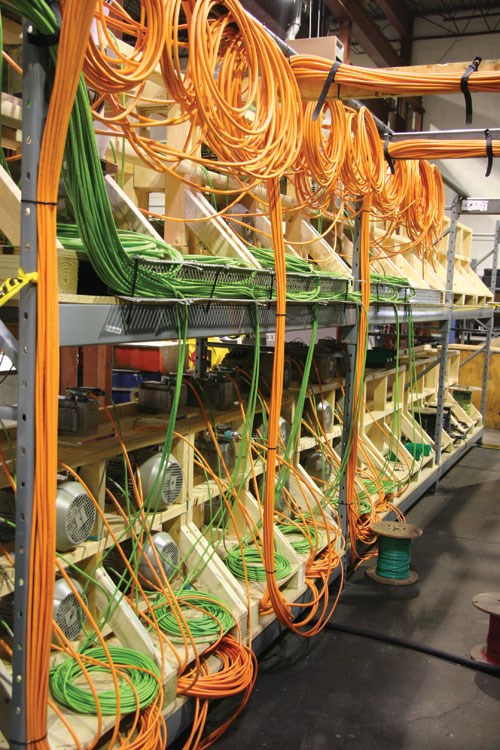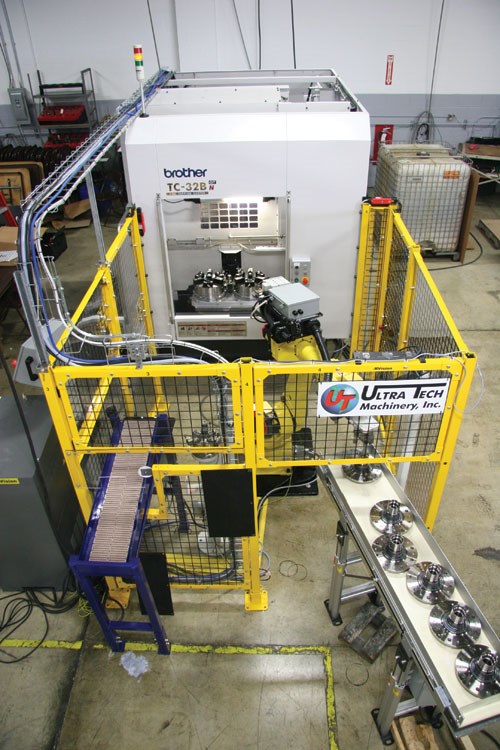Upgrading Rotary Transfer Machines on the Shop Floor
Smart manufacturers are using slower production demand to upgrade efficiency of their rotary transfer machines. This story looks at a Cleveland area integrator that can do the job in weeks and without removing machines from the shop.
In the old TV series “Six Million Dollar Man,” the intro says something to the effect, “We have the technology…We can make him better, stronger, faster.” It’s similar to the approach that Ultra Tech Machinery (Cuyahoga Falls, Ohio) takes to upgrading machine tools—especially large rotary transfer machines—but for much less money.
“Our goal in taking an upgrade project,” says Bob Hagarty, vice president, “is to restore candidate machine tools to better than new condition. Our objective is to improve production efficiencies that are now possible with current controls and drives. Plus, by using commercial electronics as opposed to proprietary OEM controls and drives, the shop can significantly reduce or postpone its maintenance costs, downtime and control obsolescence ongoing.”
Ultra Tech recently finished a rotary transfer upgrade project for a key OEM manufacturer, and that project is what this article focuses on. Because of confidentiality agreements with the OEM, we are limited to discussing the project generically, but that should suffice for understanding Ultra Tech’s capability and competitive advantage in upgrading this class of machine tools.
Seizing an Opportunity
The mass manufacturing spectrum—Tier One automotive, hydraulic, consumer products, industrial fittings, valves, pneumatics, and more—have long relied on rotary transfer technology for high production. These are big, multi-station rotaries with dial-type or machining center-type workstations.
In the 1990s, numerous CNC versions of these machine tools were purchased to replace the previous hydraulic and mechanical generation.
As was common then, the machine tool builders used proprietary CNC technology, programming and servo technology in large part because the multi-axis complexity of these machines required it. No single off-the-shelf CNC at that time could handle the channels needed to operate the 65-70 axes required to run these machines. Like the “Six Million Dollar Man,” we now have the technology.
Since the economy has slowed down, some of the contract shops running these big rotaries are using the time to upgrade the electronics on their machines. They are trying to improve productivity, flexibility and automation to be in a more competitive position when the economy turns up. For the most part, the iron on these machines is good, but the electronics
are obsolete.
The problem some are having is that rebuilding or upgrading these machines can involve sending the machines back to the OEM in Europe, or whatever the country of origin. This may represent a 5- to 6-month turnaround without the use of the machine.
Ultra Tech’s alternative is to reduce this downtime to 6 to 8 weeks, while performing a complete upgrade to the machines on the customer’s shop floor. As a custom machine tool builder and automation integrator, the company understands the need to minimize production disruption for high-volume producers.
Getting the Project
The project began with an Ultra Tech customer that was interested in replacing existing robotics to two existing rotary transfer machines in order to expedite part load/unload. Ultra Tech is an authorized Fanuc robotics systems integrator.
“The decision facing the shop was to take the relatively safe road of using the OEM or to take a risk on a third party such as us.,” Mr. Hagarty says. “Bear in mind these are large, complex machines that run $3 million to $5 million a copy new, and the shop has multiple machines, so the decision wasn’t trivial. To make a long negotiation short, they went with us.”
The candidates for this upgrade are 14-station rotary transfer machines that are horizontal trunnion type by virtue of up, down and front machining units that machine both ends of the workpieces. Most spindle units are single axes, but some could be dual- or three-axis units used for contouring. The work cube for these machines is 4-inch by 4-inch. The original machine was serviced by two integral robot handlers, which Ultra Tech reduced to one Fanuc robot for the upgrade while still maintaining cycle time.
Some of the nuggets that Ultra Tech brought to the table included the option of installing a non-proprietary control and servo drive system instead of the single control choice available from the OEM. The ability to choose from standard control systems, and by virtue of ongoing upgrades, allowed a guarantee of 12-year serviceability.
But the driving factor for the shop’s decision to go with a local third party integrator was the significant reduction in downtime on the shop floor. In the case of the first machine upgrade, downtime was 8 weeks. The second machine was offline only 6 weeks. In addition, having resources domestically sourced, including service, engineering and project management, ensured the customer access to these resources ongoing.
Beyond a Rebuild
One of the first hurdles to overcome with the customer was to explain the current state-of-the-art control and drive technology and that not only can it replicate the performance of the old CNC technology, but it brings much more capability to the machine’s operation than before. “When these machines were built 10 to 15 years ago,” Mr. Hagarty says, “no standard control could handle the number of axes and programs that needed to run the machine tool. Because Ultra Tech builds its own large rotary transfer machines and has experience using the latest standard CNC and drives on its own equipment, the fact that it works and works well was less of a leap of faith for the customer.”
That first-hand experience also allowed improvements in flexibility that the original control could not provide. For example, the upgrade allows fixtures to be opened independently, which made setup much easier than the old all-or-nothing command.
When tracking a part around the carousel, the new technology enables the operator to turn off a
fixture or not and turn off a station or not—none of this could be done before the upgrade. So if one
fixture went down on the old system the entire machine had to be shut down because the machine would not cut air.
“Machining on a rotary is progressive,” Mr. Hagarty explains. “Station 2 drills, Station 3 reams; so if Station 2 didn’t get finished with its operation and indexed to Station 3, it would crash Station 3. With the upgrade, if Station 2 doesn’t finish its operation, Station 3 will not operate and the part will be rejected automatically.”
To accomplish this, each station uses 32 “status bits” to establish what is happening to the part. “We now can put more brains in the machine than it ever had before,” Mr. Hagarty says.
With the malfunctioning station or fixture turned off, all of the subsequent stations will ignore it while the machine can continue to run with—in the case of the project machine—13 out of 14 fixtures. When the fixture or station is back online, the incomplete part or parts can be rerun rather than scrapped.
Big Changes in Execution
Each of the customer’s rotary transfer machines runs more than 30 discrete programs. The customer programmed its original equipment Allen Bradley 8600 control using a software package developed in house. Because they are making families of parts, only the features that machine differently need to be written using the M and G codes for the A/B control.
“Part of our contract was to either rewrite the customers existing parametric conversion software or to write our own conversion software to convert the customer’s old programs to Siemens language,” Mr. Hagarty says. “So, we wrote a separate program that would take the output of 30-plus part programs from the old control and automatically convert them to Siemens code. We didn’t touch the customer’s original programs. Now the customer is able to hit a button, do the conversion, and it automatically downloads the program, via Ethernet, into the Siemens control.”
All of this additional flexibility had an impact on setup. Many of the parts made on these rotaries use the same tooling. Before the upgrade, to change from one part to another required downloading a program to each station and changing out all of the tooling (even if the new part used it) to reset all the tool points.
Now, with the new programming system, the customer can leave the tools that are the same in the machine and only change those few tools that are different. Each station around the dial is displayed individually on the CNC, so setup is required only for the stations that need to change for the new job.
Ultra Tech replaced the customer’s old tool presetter software. The new software can capture tool offset data offline and download it directly into the Siemens control. To run a new job, the operator simply touches up on the tool and the rest automatically set off of that datum.
For example, of the 30-plus spindles on the machine, only 16 are running a different operation than the previous part. The tooling for the other 16 spindles are left alone. With the old system, all of them had to be attended—a significant reduction in setup time.
Pushing the Envelope
In addition to the Siemens 840D, which serves as the master control, four separate CNCs are required for the upgrade of these complex machines. “Tying four CNCs through a single control station was not common for Siemens,” Mr. Hagarty says. “And they made it work seamlessly. These are separate controls, each with a sphere of operation, but when one control hands off to another, it is transparent to the operator. The 840D interface looks and acts like a normal CNC to the operator.”
The control limitation was not the number of axes it could handle, but rather the number of programs required. Each CNC is capable of processing 20 axes, but only ten program output channels were available on a given control. Since the customer needed random access to 30-plus resident programs, four CNCs were required.
Compressing Time
The total build time for the upgrade was 38 weeks from the purchase order to production on the customer’s floor. However, through use of a cell simulation at Ultra Tech’s facility, the customer’s production was only impacted for 8 weeks on machine No. 1 and 6 weeks on the remaining machines.
“We were able to commission this entire project before it left our shop,” Mr. Hagarty says. “The only shopfloor time we required from the customer was the physical removal of the old and installation of the new CNCs and drives as well as removal of the original two robots and installation of the single Fanuc. Because of the simulation work done at our facility the actual installation was literally plug-and-play.”
The simulation consisted of constructing racks to hold the spindle drive motors and axis servomotors. All of the motors were wired to the electronic cabinet, which holds the four CNCs and motion control cards.
Using the part programs supplied by the customer, Ultra Tech was able to simulate and prove-out each station’s role in each part program, in effect, remotely running each job at the company’s facility.
Some Upgrade Considerations
Mr. Hagarty estimates that the installed base for large CNC rotary transfer machines, such as his project machine, to be roughly 1,000 units. Most of these were sold in the mid to late 1990s, and at 10-years-plus in age, are candidates for upgrading.
One of the results Ultra Tech’s customer has realized is setup time reduction. Unscheduled downtime from electrical issues has gone from about 25 percent downtime to almost zero.
Mr. Hagarty says, “The question that shops running this class of machine tool should ask themselves is, ‘Is a brand new machine going to get me half the cycle time or three-fourths the cycle time of my old machine?’ Speeds, feeds and fixturing dictate that. We don’t see new rotary transfer machines cutting parts much faster than the old machines. Savings are being found in shorter setups, scrap reduction and production flexibility, for which we can electrically upgrade an older machine at about 25 percent of the cost of a new machine.”
Related Content
Avoid the 7 Deadly Sins of Manufacturing
Identifying and preventing these manufacturing sins will reduce or eliminate unnecessary waste, improve efficiency and productivity as well as protect profitability and cash flow.
Read MorePrecision Machining Technology Review: December 2023
Production Machining’s December 2023 technology showcase includes some of the latest technology from Sandvik Coromant, Nikon Metrology, The L.S. Starrett Co., Walter USA, Kennametal and SolidCAM.
Read MoreSoftware Controls Chip Breaking in Thread Turning Operations
This cutting tool manufacturer has developed a software module for chip control of thread turning operations in virtually any CNC lathe, even for older machines, using specific tooling and software.
Read MoreHack-Proof Your Shop: Production Machining’s 6 Must-Read Cybersecurity Articles
October is cybersecurity awareness month and Production Machining wants to help you make your shop hack-proof.
Read MoreRead Next
Do You Have Single Points of Failure?
Plans need to be in place before a catastrophic event occurs.
Read MoreA Tooling Workshop Worth a Visit
Marubeni Citizen-Cincom’s tooling and accessory workshop offers a chance to learn more about ancillary devices that can boost machining efficiency and capability.
Read More5 Aspects of PMTS I Appreciate
The three-day edition of the 2025 Precision Machining Technology Show kicks off at the start of April. I’ll be there, and here are some reasons why.
Read More



















.jpg;maxWidth=300;quality=90)







